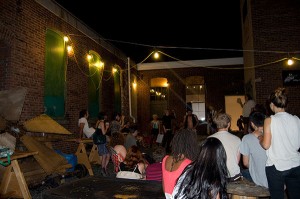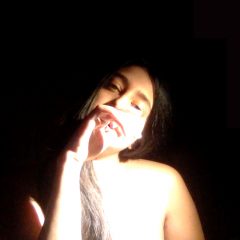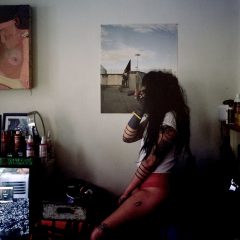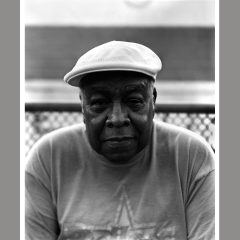The artists in Materialism of Encounter want to dispel the idea that a focus on the physical is a sign of a lack of ideas or superficial thought. With the viewer’s experience being in part, physical, material qualities can not be ignored.
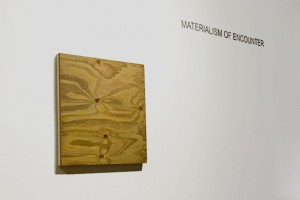
Conor Backman’s “Project Panel” reflects an interest in the separation between painting and sculpture. When viewed from a frontal perspective, the trompe l’oeil canvas resembles a panel of hardwood. However, the artist is not interested in simply creating an illusion. When viewed from another perspective, the canvas’ unpainted sides, primed in white, become visible and reinforce the painting’s flatness. Backman’s decision to represent wood, the canvas’ underlying support, suggests the painting’s sculptural quality.
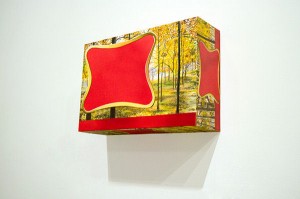
The artist’s other paintings are also concerned with recreating the familiar. His boxy paintings of beer cases do not include any identifying text. Instead, each brand’s use of landscape imagery points to the commodification of art.
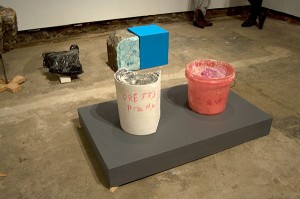
With objects that are at first confounding and difficult to characterize, Matt Brett’s installation “The Winter, the Work, and the Thrash” is an examination of materials and processes. Using plaster and found objects, the artist creates forms using a variety of techniques. The work’s title suggests a farmer’s diligent work schedule and the artist’s use of layered processes to create objects that are constantly changing.
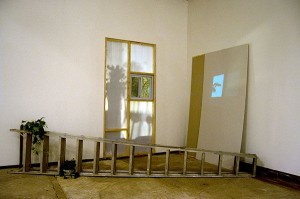
In “Places Where My Friends Live(d),” Masha Badinter creates an environment that recalls a remembered experience. From the title and a looping video projection of shadows of leaves swaying in blue light, the work seems like a memory of nights spent with friends. A horizontally-placed ladder serves as a physical divide, and the inclusion of potted plants between rungs suggests a domestic setting. Removed of its function, the ladder cannot be used to climb through a window on the opposite wall, and viewers are only given a glimpse at the interior space beyond. As a place that cannot be fully accessed, the window serves as a metaphor for memory itself as well as the longing for a past experience.
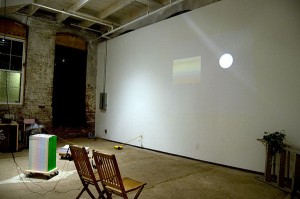
Joanie Turbek’s audio installation, “It’s Raining Out Your Window” provides a space to sit and listen to a looping soundtrack of falling rain. The physical experience is soothing and meditative like the adjacent work, Alexandra Barao’s projected videos of celestial events. “Moon Rises” is a time-lapse video of the moon’s nightly climb, and “Reflections on and of the Sunset” is a series of changing color gradients that recalls the sky’s bands of color. Each artist’s minimal approach makes the works immediately felt and relatable.
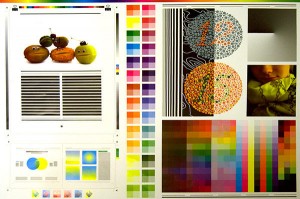
Sean Kuhnke and Bryan Jabs’ two-sided, takeaway prints look at the changing status of print media. One side resembles a sample page layout complete with color swatches, value gradients, and other identifying marks. The inclusion of standard colorblind tests further highlights that the work is intended for printed use.
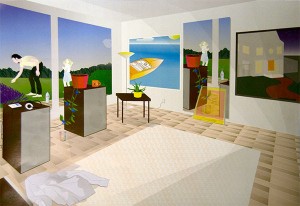
With images that seem culled from the Internet, the work looks at the transition to digital technologies and the unforeseeable future for printed communication. The use of low-tech, vector images to illustrate a domestic scene on the other side marks the beginning of a digital age and the changing relationship between art and technology.
Materialism of Encounter seems like a return to fundamentals. By seeing the potential in the physical to create an experience, the artists prove that concerns about form are not necessarily empty or meaningless, but rather, a springboard for deep thought. If you haven’t seen the show but want to, you can see it today from 6-9 pm at Little Berlin. Or contact LB to make an appointment.
